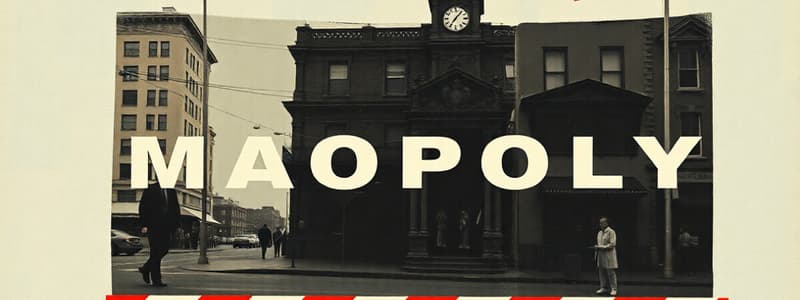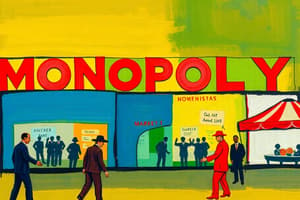Podcast
Questions and Answers
Which of the following is a primary characteristic of a monopoly?
Which of the following is a primary characteristic of a monopoly?
- A single seller dominating the market (correct)
- Prices determined by market supply and demand
- Free entry and exit for firms
- Numerous competitors offering similar products
What is the most significant implication of a firm possessing market power?
What is the most significant implication of a firm possessing market power?
- Inability to influence market prices
- Capacity to determine price and output without risk of competitors undercutting (correct)
- Dependence on government subsidies for survival
- Need to accept prevailing market prices
Which factor is least likely to be a substantial barrier to entry in a monopolistic market?
Which factor is least likely to be a substantial barrier to entry in a monopolistic market?
- Low initial capital requirements (correct)
- Economies of scale enjoyed by existing firms
- Stringent legal protections like patents
- Strong brand loyalty
How does the demand curve faced by a monopolist typically appear?
How does the demand curve faced by a monopolist typically appear?
For a monopoly, how is marginal revenue (MR) related to average revenue (AR)?
For a monopoly, how is marginal revenue (MR) related to average revenue (AR)?
What happens to the price elasticity of demand as a monopolist increases the price?
What happens to the price elasticity of demand as a monopolist increases the price?
At what point does a monopolist maximize profit?
At what point does a monopolist maximize profit?
How does a monopolist determine the price once the optimal output is determined?
How does a monopolist determine the price once the optimal output is determined?
What is a key difference between perfect competition and monopoly regarding long-run profits?
What is a key difference between perfect competition and monopoly regarding long-run profits?
Which of the following is most likely to occur in a monopolized market compared to a perfectly competitive market?
Which of the following is most likely to occur in a monopolized market compared to a perfectly competitive market?
In the context of a monopoly, if the slope of the AR curve is -1, what will be the slope of the MR curve?
In the context of a monopoly, if the slope of the AR curve is -1, what will be the slope of the MR curve?
If a monopolist operates in the elastic portion of the AR curve, what strategic move would likely increase revenue?
If a monopolist operates in the elastic portion of the AR curve, what strategic move would likely increase revenue?
Why might a monopoly not have a strong incentive to innovate?
Why might a monopoly not have a strong incentive to innovate?
According to the image, which one of the following factors is not shown as leading to barriers of entry?
According to the image, which one of the following factors is not shown as leading to barriers of entry?
In the diagram outlining profit maximizing under monopoly, at which point do you maximize profits?
In the diagram outlining profit maximizing under monopoly, at which point do you maximize profits?
The following statement is true regarding monopolies in the long run:
The following statement is true regarding monopolies in the long run:
According to the diagram, which letter gives the profit maximizing price?
According to the diagram, which letter gives the profit maximizing price?
Consider the typical comparison between monopoly and perfect competition. Which statement accurately reflects an outcome under monopoly?
Consider the typical comparison between monopoly and perfect competition. Which statement accurately reflects an outcome under monopoly?
In the image of contrasting perfect competition and monopoly, what does the area between AR and AC illustrate?
In the image of contrasting perfect competition and monopoly, what does the area between AR and AC illustrate?
According to the diagram, in Output and Price for Monopoly Vs Perfect Competition, is the following statement correct: Monopoly output is higher and price is lower
According to the diagram, in Output and Price for Monopoly Vs Perfect Competition, is the following statement correct: Monopoly output is higher and price is lower
Flashcards
What is a Monopoly?
What is a Monopoly?
A market structure where a single seller controls the entire supply of a product or service.
What is Market Power?
What is Market Power?
A situation where a company can set prices and output without fear of being undercut by competitors
What are Barriers to Entry?
What are Barriers to Entry?
Factors preventing new competitors from entering a market.
What are Economies of Scale/Scope?
What are Economies of Scale/Scope?
Signup and view all the flashcards
What is Product Differentiation/Brand Loyalty?
What is Product Differentiation/Brand Loyalty?
Signup and view all the flashcards
What are Lower Costs for Established Firms?
What are Lower Costs for Established Firms?
Signup and view all the flashcards
What is Ownership/Control of Key Factors/Outlets?
What is Ownership/Control of Key Factors/Outlets?
Signup and view all the flashcards
What is Legal Protection?
What is Legal Protection?
Signup and view all the flashcards
What are Mergers and Takeovers?
What are Mergers and Takeovers?
Signup and view all the flashcards
What are Retained Profits & Aggressive Tactics?
What are Retained Profits & Aggressive Tactics?
Signup and view all the flashcards
What is a Monopolist's Demand Curve?
What is a Monopolist's Demand Curve?
Signup and view all the flashcards
What is Marginal Revenue (MR)?
What is Marginal Revenue (MR)?
Signup and view all the flashcards
What is Profit-Maximizing Output?
What is Profit-Maximizing Output?
Signup and view all the flashcards
What is Supernormal Profit?
What is Supernormal Profit?
Signup and view all the flashcards
Monopoly vs Perfect Competition: Output and Price
Monopoly vs Perfect Competition: Output and Price
Signup and view all the flashcards
Monopoly vs Perfect Competition: Innovation
Monopoly vs Perfect Competition: Innovation
Signup and view all the flashcards
Define Monopoly.
Define Monopoly.
Signup and view all the flashcards
What is the shape of a monopolist demand curve?
What is the shape of a monopolist demand curve?
Signup and view all the flashcards
How does a monopoly maximize it's profit?
How does a monopoly maximize it's profit?
Signup and view all the flashcards
What is Perfect Competition?
What is Perfect Competition?
Signup and view all the flashcards
Study Notes
- Monopoly is a market structure characterized by a single seller, unique product, and significant barriers to entry.
Defining Monopoly
- A monopoly has the power to set the price of its product due to a lack of competition.
- Market power enables a monopoly to determine price and output without the risk of being undercut.
Sources of Barriers to Entry
- Factors that prevent new firms from entering a monopolized market include economies of scale, product differentiation, brand loyalty, lower costs for established firms, ownership/control of key factors or outlets, legal protection, mergers, takeovers, retained profits, and aggressive tactics.
TMA and Maldivian Air Taxi
- Blackstone acquired TMA and Maldivian Air Taxi in 2013 with 48 aircrafts, leading to increased seaplane contract prices
- There was a reduction in services and benefits to hospitality groups and an exclusivity clause prevented deals with other seaplane operators.
- There was a contractual link to use landplane operations, allegedly planned by TMA.
- A minimum contract term of three years for seaplane operations was imposed.
- Manta Air entered the market in 2019 with 3 seaplanes.
Monopoly Demand Curve
- A monopolist faces a downward-sloping demand curve.
- The greater the market power, the less elastic (steeper) the demand curve.
- Marginal Revenue (MR) is below Average Revenue (AR), also known as the Demand curve (D).
- The slope of the MR curve is twice that of the AR curve
- For every £1 change in AR results in a £2 change in MR.
- Monopolies operate in the elastic portion of the AR curve, where price increases lead to higher revenue.
Profit Maximization
- Profit is maximized at the output level where Marginal Cost (MC) equals Marginal Revenue (MR).
- The profit-maximizing price is found on the demand curve (where Demand = Average Revenue).
- Supernormal profits can persist in the long run due to barriers to entry.
Monopoly vs. Perfect Competition
- Compared to perfect competition, monopolies produce lower short-run output at a higher price as the market is not flooded.
- Costs may remain high due to a lack of competition and no incentive to drive costs down.
- There is less incentive to innovate in monopolies; however, there is a greater possibility of Research and Development (R&D) and innovation through the investment of ploughed-back profit.
- Monopoly profit may encourage risk-taking and the development of new industries.
Output and Price Comparison
- In monopolies output is lower and price is higher than in perfect competition.
Studying That Suits You
Use AI to generate personalized quizzes and flashcards to suit your learning preferences.




